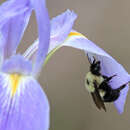Life Cycle
provided by EOL authors
Bumble bees are social bees and have annual nests. A queen will emerge from hibernation in early spring and start her own colony. Worker bees develop first, followed by males and new queens towards the end of summer. A bumble bee nest often contains between 300 and 500 individuals. Newly mated queens will hibernate in the ground over winter; worker bees, males, and the old queen die in the fall. Bumble bees eat only nectar and pollen and do not produce large amounts of honey.
- license
- cc-publicdomain
- copyright
- National Biological Information Infrastructure (NBII) at http://www.nbii.gov
Brief Summary
provided by EOL authors
The common eastern bumble bee (Bombus impatiens) is so named because it is native to the eastern part of North America. They are native from Ontario to Maine and south to Florida; introduced in California and in British Columbia, Canada. Queen bees are larger than both the drones and workers, ranging from 17 to 21 mm long. Drones are between 12 and 17 mm long and typically black. Workers are between 8.5 and 16 mm long and resemble the queen. Bombus impatiens nest in open fields and woods.
- license
- cc-publicdomain
- copyright
- National Biological Information Infrastructure (NBII) at http://www.nbii.gov
Pollinator
provided by EOL authors
After populations of the western bumble bee (Bombus occidentalis) were decimated by the introduction of exotic disease organisms, the Animal and Plant Health Inspection Service (APHIS) allowed transportation and introduction of the common eastern bumble bee into the western United States in 1998. This species was also allowed into British Columbia in 1999. However, there are concerns about the effects of importing this non-native bee species into the western United States, specifically in California. The Xerces Society for Invertebrate Conservation filed comments against the effort, citing unknown outcomes and ecological risks associated with importation of the bee.
These bumble bees are reared commercially and they are important pollinators of greenhouse tomatoes and blueberries, with research showing positive correlations between the density of common eastern bumble bees and blueberry fruit set as well as the number of large seeds per berry up to 150 m from the hive. Of the three commercially available pollinators of Maine blueberries - honey bees (Apis mellifera), alfalfa leafcutter bees (Megachile rotundata), and common eastern bumble bees (Bombus impatiens) - the common eastern bumble bee may be the most efficient pollinator. It pollinates flowers faster than and at cooler temperatures than honey and alfalfa leafcutter bees and is more faithful to the blueberry crop, even if alternate forage is available. Additionally, common eastern bumble bees will fly in moderate rain. The common eastern bumble bee is at least two to 10 times more efficient at pollinating blueberry than one honey bee. However, common eastern bumble bee colonies are more expensive to use than honey and alfalfa leafcutter bees because they can be used during only one season. These bees are also important pollinators of prairie ecosystems, preferring to forage on Culver's root (Veronicastrum virginicum) but also pollinating wild bergamot (Monarda fistulosa) and aster (Asteraceae) in late summer.
- license
- cc-publicdomain
- copyright
- National Biological Information Infrastructure (NBII) at http://www.nbii.gov

